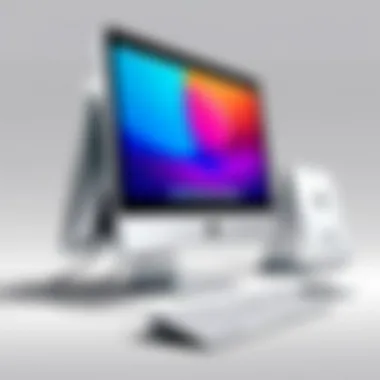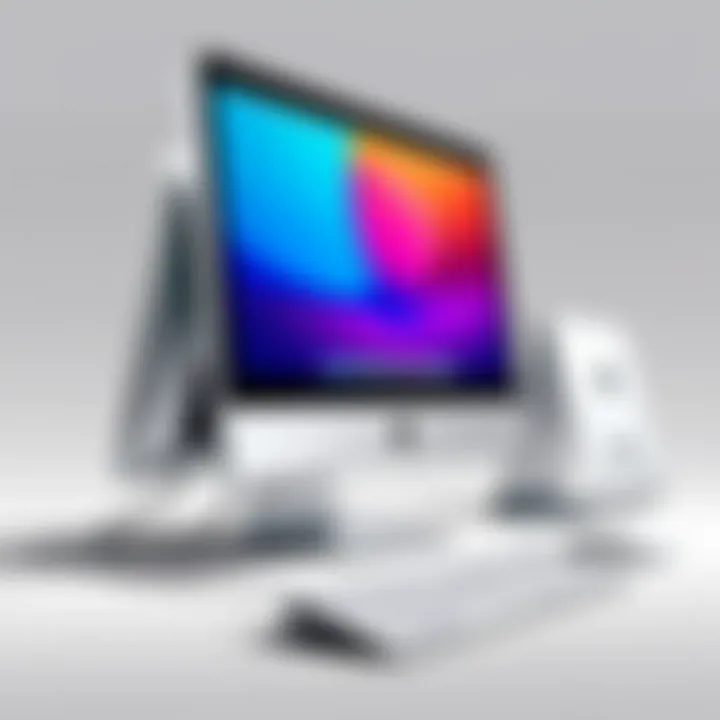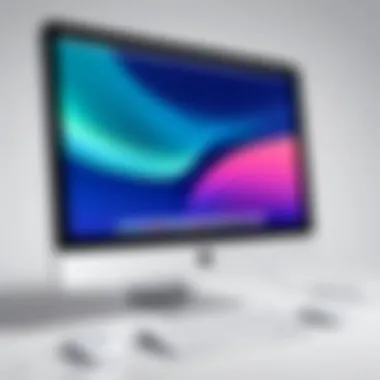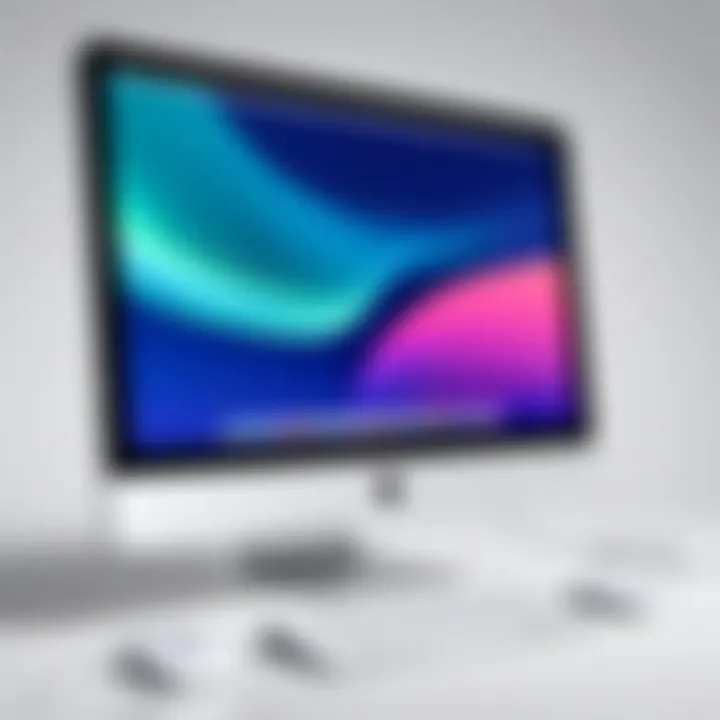A Deep Dive into iMac Models Through the Years


Intro
The iMac has become more than just a personal computer; it symbolizes a design philosophy that marries functionality with aesthetics. Over the years, it has significantly transformed how users interact with technology. From its debut in 1998 to the modern iterations, each model showcases Apple's relentless pursuit of innovation and user-centric design.
Understanding the evolution of iMac year models isn't merely about grasping technical specifications; it’s about appreciating how these advancements resonate with users and their experiences. As we journey through its various iterations, we will not only highlight notable changes in hardware and design but also delve into the context in which these advancements occurred, illustrating why iMac holds its revered status in the tech landscape.
"The iMac's journey reflects a commitment to pushing the boundaries of what a personal computer can be, both in design and performance."
In the sections that follow, we will examine the key features that define the iMac through the years, including insights into its design and build quality as well as display and performance. Afterwards, we will lay out the technical specifications, compatibility, and connectivity characteristics that have marked each generation's release, solidifying the iMac's place in personal computing history. The overarching aim is to provide a comprehensive overview of the iMac's legacy, exploring its significance not just to Apple but to the entire computer industry.
Preface to iMac
The iMac has established itself as a cornerstone of modern personal computing, intertwining aesthetics with functionality in ways that few other devices can claim. Its importance in this article cannot be overstated. When we explore the history and evolution of the iMac, we’re not just recounting a timeline of technological advancements; we’re diving into how a single product reshaped the landscape of consumer technology.
At the outset, one must consider the unique design philosophy behind the iMac. Unlike many computing machines of its time that favored utility over beauty, the iMac was born out of a desire to break the mold. Its vibrant colors and alluring shapes screamed individuality, claiming a spot not just on desks but in the hearts of its users. This blend of form and function meant that the iMac wasn't merely a tool; it became a lifestyle choice.
Further, there's the matter of user experience. The iMac dared to introduce features that profoundly changed how people interacted with their computers. Think back to its intuitive graphical interface, which made computing accessible even to those who previously felt overwhelmed by technology.
"The iMac didn't just deliver technology; it invited everyone to the table."
In this article, we will cover specific elements such as the influence of the iMac on subsequent models and its ripple effect through personal computing history. Understanding the iMac’s evolution is pivotal in recognizing how design trends, user needs, and technological innovations converge over time.
Also, throughout this overview, we will highlight not just the standout features but also the nuances of public perception and its commercial journey. We’ll delve into invaluable insights about how shifts in consumer behavior influenced every iteration of the iMac, shaping it into a brand that's responsive to the needs of a dynamic marketplace.
In summary, the iMac is more than just a collection of specifications; it embodies a story that connects technology, design, and the human experience. By tracing its journey through the years, this article aims to illuminate its significant contributions to the world of personal computing.
The Birth of the iMac
The inception of the iMac heralded a transformative period not only for Apple but for the entire landscape of personal computing. It represented a bold departure from the prevailing design and functionality norms of its time. The iMac brought a fusion of technology and art to the consumer space—reshaping expectations around what a computer could look like. This marked a significant milestone that spurred innovation across the industry, influencing various fields from marketing to design philosophy.
The Original iMac Release
Design Philosophy
The iMac was launched in 1998, and its design philosophy was rooted in accessibility and contemporary aesthetics. The curvier, translucent shell of the original unit broke away from the traditional beige boxes that dominated the market. Apple's design team aimed to create a product that was not only functional but also visually appealing.
One key characteristic of this design was its all-in-one structure, which meant that the monitor and computer were combined into a singular unit. This innovation helped in reducing desk clutter, an incredibly appealing feature for households and offices alike. Qualities such as ease of use and vibrant color options made the iMac stand out in a sea of dull grey and beige computers. Its unique feature, the colorful body, appealed to a younger demographic, which was an advantage for Apple in capturing market share against competitors.
However, this striking design did come with its shortcomings. While it attracted attention and praise, some users felt that the aesthetic appeal overshadowed technical specifications, leading to skeptical evaluations from tech enthusiasts at the time.
Market Reception
Upon its debut, the iMac received a mixed market reception. Many tech journalists and consumers lauded its innovative design and user-friendly interface, but there were skeptics too. One notable trait of the market reception was visible enthusiasm from the non-tech-savvy audience who found the iMac approachable.
What made the iMac a beneficial choice in terms of market reception was its effective marketing strategy—highlighting its ease of use and sophisticated appearance. This contributed to its swift rise in popularity. A unique feature was the "iMac specials" that included the iMac itself with added accessories at reduced prices to lure in first-time buyers.
But on the flip side, its initial price point was a hurdle for many potential customers, particularly those used to lower-priced alternatives. The dichotomy in market opinions effectively set the stage for how Apple would eventually re-shape its user base across diverse demographics.
Impact on Personal Computing
User Interface Innovations
The launch of the iMac was accompanied by groundbreaking user interface innovations, making it significantly important in assessing its impact on personal computing. The introduction of features like transparency in the operating system and the use of icons for file management made using a computer feel less like solving a puzzle and more like navigating a digital world.
A core highlight of user interface innovations was the graphical user interface (GUI), which radically simplified user interactions, moving away from command lines and text-based inputs. This design sensibility attracted a broader audience, including those unfamiliar with technology—an important advancement for user inclusivity.
One of the unique elements of these innovations was the comprehensive approach to software that encouraged creative engagement, demonstrating that tech could be engaging rather than just practical.
Influence on Future Models
The impact of the original iMac extended well beyond its commercial success; it fundamentally influenced subsequent models and competitors. The overall idea of merging stylish design with practical functionality set a new market standard. Apple's emphasis on aesthetic details led to the evolution of future models like the iMac G4 and beyond.
One essential characteristic of this influence lay in the design ethos that prioritized both form and function, inspiring numerous manufacturers to adopt similar principles. This enduring focus on aesthetics helped Apple cultivate a loyal following and appealed to users beyond the tech community.
Yet, it was this sharp focus that also risked alienating users more concerned with technical specifications than design swank. Nevertheless, the impact remains significant, marking a turning point that pushed the boundaries of modern computing.
Chronological Overview of iMac Models
The exploration of iMac year models offers a crucial context for understanding the evolution of personal computing. This section chronicles the significant milestones in the life of the iMac, illustrating how each iteration contributed to technological and design innovations over time. The takeaway from this narrative is simple: the iMac does not just reflect changes in hardware but also represents shifting consumer preferences and market dynamics.
Late Nineties to Early Two Thousands
Key Features
During this period, the original iMac was marked by its vibrant colors and unique form factor. Most notably, the original iMac G3 was among the first to integrate USB ports while eschewing floppy drives—an audacious move that hinted at the future of computing. The all-in-one design and playful colors were appealing, making it stand out in a sea of beige PCs.
What made the iMac G3 a hit? The combination of user-friendliness, aesthetic appeal, and cutting-edge technology ushered in a new generation of computers, aligning well with the emerging internet culture of the late 90s. Those characteristics not only attracted tech enthusiasts but also casual users looking for a fresh computing experience.
The seamless blend of design and function provided the advantage of saving table space while offering superior functionality. However, the question of durability arose for many users. The plastic casing was stylish but not impervious to scratches and wear.
Consumer Feedback
Consumer reception of the late 90s iMac models was overwhelmingly positive, primarily due to their visually appealing design and innovative features. Users quickly praised the ease of setup and intuitive interface, fostering a sense of community among early adopters. The feedback loop turned into a potent marketing tool, as satisfied customers became evangelizers for the brand.
Interestingly, there were users who voiced concerns over adaptability. Some felt uncomfortable with the interface changes that came with the discontinuation of familiar features like the floppy disk. While many consumers loved the shift to USB, a small contingent hesitated to embrace change entirely. It's essential to consider how such mixed reactions shaped Apple's approach in later models.
The Transition to Intel Processors
Performance Improvements
In 2006, Apple made a monumental shift by transitioning to Intel processors, which unlocked improved performance metrics. This upgrade allowed iMacs to run Windows through Boot Camp, effectively widening their appeal and market share. Performance became a hallmark of the iMac line, highlighting capabilities in graphics-intensive applications and seamless multitasking.
This open-door policy for Windows users marked a pivotal moment in its evolution, drawing in a more serious user base who were previously dedicated to Windows. Moreover, with Intel, the power consumption was better managed, resulting in energy-efficient machines that were still capable of high performance.
However, while this transition opened many doors, it also meant that Apple had to fine-tune its own operating system to optimize compatibility with Intel architecture. Such adjustments must be acknowledged when evaluating this leap forward.


New User Base
The decision to incorporate Intel processors attracted a diversified user base. Not only did long-time Apple fans remain, but also traditional PC users began to explore what the iMac had to offer. This diverse demographic shift established the iMac as a serious contender in various markets—graphic designers, gamers, and general-users alike found a new playground in the iMac ecosystem.
The blend of high performance and appealing design attracted professionals seeking power without sacrificing aesthetics. Still, it can’t be said that moving to Intel came without challenges. Existing users had to adapt to an evolving world where an Intel-based iMac could now run popular Windows applications—an adjustment for many longtime Mac enthusiasts.
Retina Display Prelude
Visual Clarity
When Apple introduced Retina displays in the iMac line, it was like seeing the world with fresh eyes. The enhancement in display technology allowed users to experience stunning visuals with unprecedented clarity. Images looked vibrant, and text appeared sharply defined—an exceptional leap that appealed to creative professionals and casual users alike. This visual clarity held practical benefits, particularly for designers, photographers, and video editors, who rely on precision.
However, with such advanced visuals came the potential constraint of increased power consumption. Users sometimes faced challenges with heat or energy demands, especially during tasks like rendering high-resolution videos. Still, many believed the trade-off was worth it for the breathtaking visual fidelity the Retina display brought.
Market Shift
The introduction of Retina displays signaled a major market shift. It forced competitors to step up their game, as consumers now had sky-high expectations for screen quality. The emphasis on visual performance became a trend that was not just unique to Apple but rippled across the entire industry.
That said, while Apple set new benchmarks, some critics raised concerns about the cost. The added focus on premium displays increased the price point for iMacs, which could price out budget-conscious consumers. This tension reflects a broader conversation about market positioning around quality versus accessibility.
Recent Models and Specifications
M1 Chip Impact
With the introduction of the M1 chip in 2020, Apple shifted from Intel processors towards its own in-house silicon, marking a transformational moment in their computing history. The performance improvements—particularly in speed and efficiency—are remarkable. Users have noted performance that far exceeds many competitors, delivering ultra-fast processing and power efficiency.
This move not only positioned the iMac as a cutting-edge machine but also responded to the needs of users seeking longevity and reliability.
However, this wasn't without hiccups; some legacy applications faced compatibility issues, forcing users to adapt or find alternatives. Despite this challenge, the advantages often overshadowed initial consumer hesitations, as the technology matured over time.
Enhanced Features
Alongside processor upgrades, recent iMac models have incorporated several enhanced features that have reshaped user experiences. From voice-enabled Siri functionality to high-fidelity speakers, the iMac’s capabilities are ever-evolving. Other features include improved camera quality for video conferencing and better thermal management to prolong device life.
These elements reflect a concerted effort to not only meet but exceed user expectations.
Yet, with these enhancements, the price tag continues to reflect such innovation. Users often find themselves weighing their desire for cutting-edge tech against their budget limitations, creating an interesting dichotomy in consumer behavior.
Overall, this section hones in on the unique characteristics that have defined iMac models over the years. By tracing key features, consumer feedback, major transitions in technology, and shifts in market expectations, readers can better appreciate the iMac’s trajectory in personal computing.
Design Evolution
The design evolution of the iMac encapsulates not just changing aesthetics but also reflects shifts in technology, consumer preferences, and market dynamics. It’s this interplay that shapes the way we interact with personal computing devices. The journey from the earlier, bulkier models to today's sleek machines showcases a commitment to both form and function. Every iteration brought significant changes aimed at enhancing user experience and accommodating advancements in technology.
From Bulky to Sleek
Design Trends
In the early days, iMacs were often defined by their substantial bulk. Heavy bodies and thick bezels made them less than appealing for the modern workspace. But over time, design trends shifted dramatically. The streamlined look of today’s models reflects cutting-edge design philosophy—minimalist yet functional. A hallmark of this transition has been the thinness of displays and the overall reduction in footprint. This not only makes for a cleaner workstation but also enhances portability.
One key characteristic of these design trends is the integration of materials like glass and aluminum, which not only offer a modern visual appeal but also durability. The aesthetic has evolved, catering to the tastes of consumers who desire elegance and functionality rolled into one coherent package. A unique feature of these trends is the introduction of the all-in-one format, which eliminates clutter by combining components into one device. This characteristic is mainly advantageous in design, but it can also lead to challenges when it comes to repair or upgrades.
User Preference Shifts
As design trends evolved, so too did user preferences. Early adopters of the iMac were more tolerant of bulky designs since they prioritized performance over aesthetics. However, as the tech-savvy audience grew sophisticated, especially among millennials and Gen Z, there was a marked shift towards sleek, stylish devices that effortlessly combine work and lifestyle elements. This shift indicates a demand for devices that are not only powerful but also visually appealing. Users increasingly seek out devices that complement their lifestyle and workspace, leading designers to prioritize sleekness in newer iterations.
The unique feature of this shift is the focus on user experience, ensuring that every curve and angle serves a functional purpose while appealing to our growing love for aesthetic beauty. While users may benefit from the sleekness and lightness of modern iMacs, it does raise questions about thermal management and component accessibility, further complicating maintenance yet tiptoeing towards greater convenience in everyday use.
Material and Build Quality Changes
With the iMac's design evolution comes a parallel journey in material and build quality. Each new model isn’t simply an upgrade; it’s a testament to Apple's commitment to craftsmanship and innovation in the tech landscape.
Sustainability Considerations
Sustainability has become a buzzword in recent years and for good reason. As consumers become increasingly aware of environmental impact, Apple has recognized the need to create machines that are not only high-performance but also eco-friendly. This shift toward sustainable materials serves not just the environment but also appeals to a growing demographic of conscious consumers who prioritize green technology. Materials like recycled aluminum have made their way into newer models, signifying a lasting change in production philosophy.
One of the unique features of this sustainability focus is the lifecycle transparency that many manufacturers, including Apple, now embrace. Products are designed with end-of-life recycling in mind, which can present challenges in sourcing materials while trying to meet increased consumer demand for environmentally friendly options.
Durability Improvements
Alongside environmental considerations, durability improvements mark another facet of the iMac's design evolution. Apple’s gradual shift to materials that withstand wear and tear is crucial in building consumer trust. The use of tougher glass and reinforced aluminum bodies ensures that users face fewer issues related to accidental damages—important for those who rely on their devices daily. The heightening of durability features has become a significant selling point as tech enthusiasts demand longevity from their devices.
These advancements allow users to enjoy peace of mind, knowing that their investment is not only sleek but is built to last. However, the challenge remains in balancing durability with the promise of a lightweight device. In some cases, heavier materials can lead to a more robust feel, yet sacrifice some portability, creating a push and pull between design and functionality that continues to challenge innovators.
Ultimately, the evolution of the iMac highlights a blend of aesthetics, sustainability, user preferences, and durability, signifying how much the landscape of personal computing has transformed within a few decades.
Technological Advancements
The landscape of personal computing has seen a remarkable transformation, and at the heart of this progression lies the iMac. Technological advancements within these systems have not only defined their performance but also reshaped how consumers interact with technology. Adoption of new hardware and innovative software significantly boosts productivity, fueling the drive toward faster, sleeker machines.
Key elements in the iMac's technological evolution include the integration of advanced processors, the shift to solid-state drives, and improvements in graphical capabilities. Each innovation carries profound benefits and considerations that propel the iMac forward in an ever-competitive market. As we dissect these components, we see a coherent narrative that not only showcases Apple's prowess in design but also underscores its commitment to enhancing user experience.
Processor Innovations
Transition from PowerPC to Intel
The switch from PowerPC to Intel processors was a watershed moment for Apple's computing line. By making this transition back in 2006, Apple aimed to harness the speed and efficiency that Intel chips could offer. One key characteristic of this change was the x86 architecture, which paved the way for vastly enhanced performance and wider software compatibility. This shift helped the iMac cater to a more extensive range of applications, appealing to users across various fields.
One unique feature of Intel processors is their support for multi-core configurations. This feature allowed users to run several applications seamlessly, making it a game-changer in multitasking scenarios. However, this transition wasn’t without its challenges, as users had to adapt to a new platform that might not have always played nicely with legacy software.
M1 and Beyond
With the introduction of the M1 chip in 2020, Apple staked its claim on the future of computing. The M1 showcased Apple's ability to innovate by combining CPU, GPU, and RAM on a single chip, which resulted in incredible efficiency. This characteristic makes it a popular choice among tech enthusiasts seeking high performance without excessive power consumption. The unique feature of the M1 is its unified memory architecture, which streamlines data flow and significantly boosts processing speed.
Advantages of the M1 include increased speed and battery life, making it an attractive option for mobile users. However, one disadvantage could be the initial compatibility issues with software not optimized for Apple silicon, although this gap has been steadily closing with new developments in macOS.
Storage and Memory Enhancements


SSD Prologue
The introduction of solid-state drives heralded a new era for the iMac, providing users with significantly faster load times and improved overall system responsiveness. One of SSD's key characteristics is its lack of moving parts compared to traditional hard drives, which makes it quieter and less prone to failure. For this article, the transition to SSD is essential because it dramatically enhances user experience, especially in data-heavy tasks.
A unique feature of SSDs is their capability to exponentially reduce boot and application launch times, streamlining the overall computing workflow. This rapid access to data offers clear advantages in efficiency but comes with a higher price tag compared to traditional HDDs, which can be a consideration for budget-conscious consumers.
RAM Upgrades
As applications continue to evolve, the demand for better multitasking capabilities has led to significant advancements in RAM technology within the iMac lineup. Highlighting this aspect shows how essential RAM upgrades are for enhancing performance across various activities, such as video editing or gaming. The ability to increase RAM capacity is a considerable benefit, allowing power users to run more applications simultaneously without experiencing lag.
The unique aspect of modern RAM is its speed — often measured in megahertz — which directly impacts how quickly data can be accessed or processed. Benefits of these upgrades include smoother operation of high-performance tasks; however, there can be compatibility issues with older models, making it critical for users to research before upgrading.
Graphics Improvements
Impact on Gaming and Design Software
Graphics capabilities have seen tremendous strides in recent iMac models, fundamentally altering how creative professionals and gamers interact with their systems. The emphasis on improved graphical output caters to burgeoning sectors like gaming and design, allowing applications to deliver stunning visuals and intricate details without a hitch. Enhanced graphics processing units (GPUs) have become indispensable for those who rely on high-performance apps.
Additionally, high-definition displays coupled with advanced GPUs create an immersive experience, positioning the iMac as a preferred choice for many creatives. However, the trade-off often comes down to cost and heat generation, which are important considerations for consumers weighing their options.
Comparative Analysis
When performing a comparative analysis of graphics capabilities across different iMac models, it's essential to consider the evolution that has taken place. Each new model tends to not only meet but exceed the expectations of previous versions, often resulting in better frame rates and enhanced performance in demanding tasks.
The key characteristic of newer graphics solutions is their ability to enable high-quality rendering in real time, which is a crucial advantage, especially for professionals in fields like 3D modeling or visual effects. However, it’s also vital to acknowledge that advances in graphics technology tend to increase electricity consumption, contributing to the overall energy cost of maintaining high-performance computing systems.
"The rapid pace of technological advancements in iMacs reflects not only the brand's dedication to innovation but also its understanding of consumer needs."
By comprehensively examining the elements defined in this section, we see how technological innovations continue to propel the iMac ahead of the pack. Each advancement is designed not merely to meet current demands but to anticipate the future of computing in an increasingly complex digital landscape.
User Experience and Ergonomics
The concept of user experience and ergonomics takes center stage in the creation of the iMac. It concerns not just how the device looks or functions, but how it fits seamlessly into a user’s routine. Smooth operation is paramount, and the ergonomics—how comfortably a device can be used—play a crucial role in the overall satisfaction of the owner. Each design decision is made with the end-user in mind, leading to devices that are not only functional but also pleasant to use.
Display Technology Improvements
High Refresh Rates
High refresh rates in iMac displays represent a leap forward in how smooth visuals can be. Today’s iMacs boast refresh rates that can exceed 120Hz. This technology contributes immensely to overall fluidity, especially in activities like gaming or video editing. The key characteristic of high refresh rates is their ability to reduce motion blur, allowing viewers to see a clearer frame even in quick action scenes. This feature proves beneficial for tech-savvy users who demand peak performance from their devices.
However, users should be aware that while high refresh rates enhance visual experiences, they also require more processing power. This can lead to increased battery drain on portable models. Balancing performance and energy consumption is, thus, a unique consideration with this advancement.
Color Accuracy
Color accuracy is another major factor bolstering the iMac’s appeal. With a focus on delivering vivid, true-to-life colors, iMacs have become preferred tools for photographers, artists, and designers alike. The displays often support a wider color gamut, such as P3, which ensures that every shade is rendered faithfully. This characteristic makes it a popular choice among professionals aiming for precise results in their work.
The unique feature of color accuracy comes into play during creative tasks—video editing, digital painting, or graphic design, where the correct color representation is crucial. While achieving such accuracy can come at a cost, it’s often worth it for those who rely on their iMacs for professional applications.
Keyboard and Trackpad Design
User Comfort
User comfort is central to the iMac experience. When designing the keyboard and trackpad, Apple has emphasized ergonomic principles. A comfortable typing experience reduces strain on hands and wrists, which is especially important during lengthy sessions. The key travel and tactile feedback of the keyboard have been finely tuned, resulting in an engaging typing sensation, beneficial for writers and programmers who spend hours at their devices.
But this comfort doesn't come without compromise. Some users have reported sensitivity issues with newer trackpad models, leading to accidental clicks. Users must find their own balance in adapting to these new designs.
Functionality
Functionality in the iMac’s keyboard and trackpad is characterized by seamless integration with macOS. Features like gesture controls on the trackpad enhance productivity, allowing users to switch between apps or scroll through documents easily. This functionality ultimately promotes a more efficient workflow.
Furthermore, the keyboard's backlit feature is not just a gimmick; it's a practical addition that proves useful in low-light settings. However, some may find that the keys feel too shallow, which can be a downside for those who prefer a different typing feel. Each design choice in this area is an intentional effort to create a harmonious user experience that caters to specific user needs.
"The combination of user-centric design and innovative technology in iMac models showcases Apple's commitment to creating exceptional computing experiences."
By diving deep into these aspects of user experience and ergonomics, the iMac continues to solidify its position not merely as a tool but rather as an integral part of a user's daily life. With attention to detail and a focus on holistic design, Apple has constructed an ecosystem where users feel valued and catered to.
Navigating Software Integration
In the landscape of computing, software integration stands as a crucial pillar that shapes user experience. Especially with iMacs, this aspect not only defines how the hardware functions but also influences how users interact with technology. Over the years, Apple has cultivated a seamless environment that enhances productivity and creativity, making the iMac a favorite among tech-savvy individuals.
Operating System Evolution
macOS Development
The evolution of the macOS operating system has considerably contributed to the iMac's reputation. The most significant aspect is its intuitive design, which emphasizes user-friendliness coupled with powerful functionalities. One must not overlook the efficiency and fluidity of operations that macOS offers. Features like Spotlight for searching and Mission Control for managing windows exemplify why users favor this operating system. Moreover, integration across devices—from iPads to iPhones—creates a cohesive experience that binds Apple enthusiasts.
A unique feature of macOS is its regular updates. Apple consistently rolls out new iterations of macOS, each enhancing performance and security. This ongoing development not only keeps users engaged but also ensures that they have access to the latest innovations. However, it does come with a downside: users often face compatibility issues with older applications or require hardware updates to fully utilize new features.
User Adaptation
When discussing user adaptation, one must consider how easily users adjust to changes in the software environment. Over the years, Apple has aimed at reducing the learning curve for new users while simultaneously accommodating experienced users who anticipate new features. The smooth transition from older macOS versions to the newer ones demonstrates this characteristic well.
One distinguishing aspect of user adaptation is the extensive ecosystem of resources available—like forums, tutorials, and FAQs—that aid in helping users navigate their settings and apps. This accessibility makes macOS a preferred choice for both beginners and seasoned pros. However, some users feel overwhelmed when confronted with new tools or features, especially those who have relied on older systems for a long time.
Software Bundles and Customization
Software bundles associated with iMacs also play a significant role in enhancing user experience. These pre-installed packages create immediate value and showcase the functionality of the operating system right out of the box. With productivity tools like iWork and creative applications such as GarageBand and iMovie, users can dive into projects without requiring additional downloads.
Pre-installed Applications
The key characteristic of these pre-installed applications is that they simplify the initial user experience. Users can start working on their documents, music, or videos without needing to hunt for suitable software. This is particularly beneficial for those who are not tech-savvy. A unique feature of the bundle is the integration of these applications with the operating system, allowing for real-time collaboration and syncing across devices. Nevertheless, some users might find the bundled apps basic compared to specialized software available in the market.
User Preferences


User preferences are increasingly shaping the software landscape of iMac computers. With flexibility in customizing software installations, users can choose what applications meet their individual needs, enhancing their iMac experience. This personalization is a significant contributor, as it allows users to craft an ecosystem that aligns better with their work style.
The unique feature here is that users can create their own workspace. Custom tools, third-party applications, or even aesthetic changes can all offer a more tailored experience for specific tasks. However, as much as customization empowers the user, it can also lead to confusion about optimal setups, creating potential barriers for those less experienced.
"In the world of iMacs, the integration of software and hardware isn't just about technology; it's about creating an ecosystem where users can thrive."
As we explore the iMac’s journey through the years, the ever-evolving software integration plays a pivotal role in shaping both the device's capability and user satisfaction. Navigating through these advancements demonstrates why iMacs continue to resonate within the personal computing sphere.
Market Positioning and Competition
Understanding market positioning and the surrounding competition is essential when discussing the iMac’s journey. This exploration allows us to contextualize the iMac not just as a product, but as a symbol within the broader personal computing sphere. The iMac's positioning in the market reflects its unique blend of functionality, aesthetics, and user loyalty.
Comparative Analysis with PC Varieties
Target Audience Differences
When we dive into target audience differences, it becomes apparent that this aspect plays a pivotal role in shaping the iMac’s market strategy. The iMac often attracts creatives, designers, and enthusiasts who value design and simplicity. These users often seek a seamless experience, which the iMac delivers through its polished interface and intuitive usability.
A key characteristic of this target audience is a preference for premium design and high performance, making affluent professionals a primary demographic. With an emphasis on multimedia capabilities and ease of use, the iMac stands out as a solid choice in the crowded tech landscape. However, one downside is that this commitment to aesthetics tends to come with a higher price point compared to many PCs, which can deter budget-conscious consumers.
In summary, understanding the target audience differences indicates that the iMac’s appeal lies not just in tech specs, but also in aligning with the values and needs of a particular user group.
Brand Loyalty
Brand loyalty is another key component that significantly shapes the iMac’s narrative in the market. Apple has cultivated a strong community of dedicated users who often remain committed to the brand across various product lines. This loyalty translates into repeat customers when new models release.
A standout feature of this loyalty is the ecosystem Apple has created. Users benefit from the ability to integrate their iMac seamlessly with other Apple devices, such as iPhones and iPads. The convenience of such a cohesive experience makes it a popular choice among existing Apple users, thereby reinforcing brand loyalty over time. However, the perception of exclusivity can sometimes alienate potential customers, making it challenging for Apple to attract users from outside its ecosystem.
To sum it up, brand loyalty greatly contributes to the iMac's ongoing success, enabling Apple to maintain a distinct presence amidst fierce competition in the tech market.
Strategic Marketing Approaches
Advertising Techniques
Examining advertising techniques unveils the sophisticated methods Apple employs to communicate the iMac's value to potential buyers. Apple's marketing focuses on storytelling—each ad paints a picture of lifestyle and creativity rather than simply hounding tech specifications. A big draw is how they showcase the iMac as not just a computer, but as a tool for empowerment, creativity, and innovation.
This strategy allows Apple to rise above the typical marketing chatter that saturates the tech industry. The unique approach appeals strongly to their target audience, providing a clear value proposition. Yet, one downside to this technique can be the lack of in-depth technical information that serious buyers might often seek, leaving some feeling under-informed about product capabilities.
In summary, advertising techniques play a vital role in shaping consumer perceptions and driving interest, making Apple's marketing both effective and distinctive.
Consumer Perception
When delving into consumer perception, it’s important to recognize how public opinion and user experiences contribute to the broader outlook on the iMac. Overall sentiment around the brand is heavily influenced by its history of innovation and quality. Users typically perceive the iMac as a reliable choice for both personal and professional use.
This positive perception bolsters Apple’s status as a market leader, which, in turn, affects sales and customer acquisition. However, there can be skepticism surrounding pricing and product upgrades—many consumers question the cost-to-benefit ratio, especially when newer models become available.
"Understanding market positioning and competition is essential for grasping the iMac’s impact and its evolution within personal computing."
Ultimately, addressing market positioning and competition helps us appreciate how the iMac has carved out its own niche in a crowded marketplace and continually evolves to meet user demands.
The Future of iMac
The iMac, an iconic player in the realm of personal computing, stands at the cusp of change and innovation. As we peer into the future, it's crucial to unpack what directions this venerable brand may take and how it continues to adapt to the ever-evolving tech landscape. The importance of this topic in the broader article hinges on understanding how the iMac will remain relevant and competitive in the wake of emerging technologies, shifting market expectations, and the perennial demand for better user experiences.
Predicted Trends and Technologies
Anticipated Features
In envisioning the future of the iMac, one can't overlook the anticipated features that promise to reshape its landscape. One specific aspect is the integration of high-performance components that will cater to both creative professionals and average users alike. A key characteristic of these features is their potential to enhance multitasking without the usual slowdowns; this has become fundamental in today's fast-paced digital environment. The introduction of modular designs may even allow users to personalize or upgrade components, making the iMac more than a one-and-done investment.
- Unique Feature: Customizability will likely see a resurgence, allowing users to swap out GPUs or RAM with relative ease.
- Advantages: This flexibility not only fosters user satisfaction but could also lengthen the lifespan of devices.
Market Expectations
As we gaze further into the crystal ball, market expectations are likely to play a significant role in shaping the iMac’s future. The demand for eco-friendly materials is at an all-time high, with consumers increasingly looking for products that reflect their environmental values. This expectation poses a challenge and an opportunity for Apple, pushing them to innovate in sustainability while maintaining their high-performance standards.
- Key Characteristic: Incorporation of recycled materials could become standard in new models.
- Unique Feature: An updated ‘green’ iMac model might emerge, appealing to environmentally conscious users.
- Advantages/Disadvantages: This would enhance brand loyalty while also facing scrutiny regarding true sustainability impact.
Impact of Emerging Technologies
AI Integration
Artificial Intelligence has become a buzzword that's hard to ignore, especially in the context of personal computing. The integration of AI functionality into the iMac could revolutionize how users interact with their machines. A notable characteristic is the potential for improved user interface interactions, such as predictive algorithms that adjust performance based on usage patterns. This responsiveness could cater to more casual users, striking a balance between sophisticated capabilities and user-friendliness.
- Unique Feature: AI-driven tools can enhance productivity by automating repetitive tasks.
- Advantages: Users could save time and stress, yet there may be concerns about data privacy and security.
Virtual Reality
The realm of Virtual Reality (VR) is rapidly expanding and presents new horizons for the iMac. Envisioning a future where VR is seamlessly integrated into the iMac experience is not far-fetched. The graphics capabilities paired with immersive environments can open up avenues in gaming, education, and collaborative workspaces.
- Key Characteristic: A robust hardware ecosystem that supports demanding VR applications could make the iMac a leading choice for developers and gamers.
- Unique Feature: A dedicated line of accessories, such as VR headsets or motion-tracking tools, may emerge alongside future iMac releases.
- Advantages/Disadvantages: While this would enrich user experiences, it might raise the bar for hardware requirements, making it less accessible to some users.
"Understanding where iMac is heading helps not just in forecasting technology trends but also in making informed personal and professional investments in tech."
In summary, as we look to the horizon, the future of iMac seems poised to intertwine advanced technology with user-centric design, sustainability, and versatility. If Apple can navigate these waters, it might just secure its position as a technology leader for years to come.
The End
As we journey through the timeline of iMac models, it’s clear that each iteration carries its own significance and contributes to the greater tapestry of personal computing. The earlier models, with their vibrant colors and quirky designs, not only disrupted market norms but also reshaped user expectations. Each redesign and technological upgrade from the original launch to contemporary variants illustrates Apple's response to consumer demands and the shifting tech landscape.
Key Takeaways
- Evolution: The design, hardware, and software enhancements over the years paint a picture of relentless progress—an evolution that reflects changing technology trends and user needs.
- User Experience: Each model has aimed to improve user interaction, from ergonomic keyboards to stunning display technologies, emphasizing the importance of user-centric design.
- Market Impact: iMac's unique positioning as a blend of functionality and aesthetics has carved out an essential spot in consumer tech, sustaining brand loyalty even in a saturated market.
- Future Outlook: Speculation on forthcoming trends hints at exciting innovations ahead, integrating emerging technologies, setting the stage for the next generation of computing.
The iMac story is not merely about a series of products; it’s a narrative involving creativity, innovation, and the willingness to challenge the status quo. Even for the tech-lovers familiar with its history, there’s always something new to glean about the nuances of its impact on personal computing. This exploration not only enriches our understanding of iMac but also encourages us to ponder what the future may hold for this iconic line of computers.
"Innovation distinguishes between a leader and a follower." —Steve Jobs
In summary, the exploration of iMac year models delivers not just knowledge of specifications but an appreciation of its lasting legacy and what it means for technology enthusiasts, developers, and everyday users alike.



